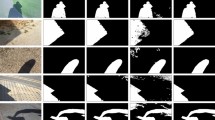Abstract
Shadow elimination is required especially when processing images captured outdoors for object recognition. Whereas room lights make diffuse shadows, the sunlight makes strong shadows leading to misrecognition of objects or some patterns such as humans or traffic signs. To remove this harmful effect of shadows on image processing, we developed a simple algorithm mimicking a human psychological characteristic about shadow detection.
Access this chapter
Tax calculation will be finalised at checkout
Purchases are for personal use only
Preview
Unable to display preview. Download preview PDF.
Similar content being viewed by others
References
Kingdom, F.A.: Color brings relief to human vision. Nat. Neurosci. 6, 641–644 (2003)
Lucassen, M.P., Walraven, J.: Quantifying color constancy: evidence for nonlinear processing of cone-specific contrast. Vision Res. 33, 739–757 (1993)
Author information
Authors and Affiliations
Editor information
Editors and Affiliations
Rights and permissions
Copyright information
© 2010 Springer-Verlag Berlin Heidelberg
About this chapter
Cite this chapter
Kamada, T., Hanazawa, A., Morie, T. (2010). Shadow Elimination Mimicking the Human Visual System. In: Hanazawa, A., Miki, T., Horio, K. (eds) Brain-Inspired Information Technology. Studies in Computational Intelligence, vol 266. Springer, Berlin, Heidelberg. https://doi.org/10.1007/978-3-642-04025-2_25
Download citation
DOI: https://doi.org/10.1007/978-3-642-04025-2_25
Publisher Name: Springer, Berlin, Heidelberg
Print ISBN: 978-3-642-04024-5
Online ISBN: 978-3-642-04025-2
eBook Packages: EngineeringEngineering (R0)




